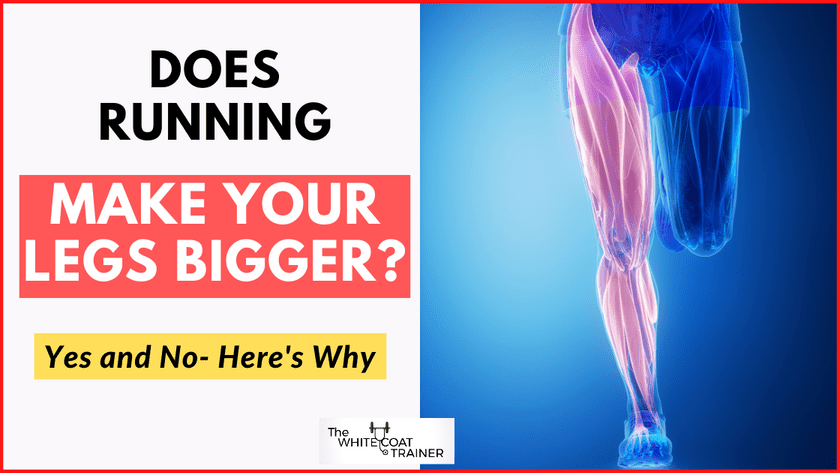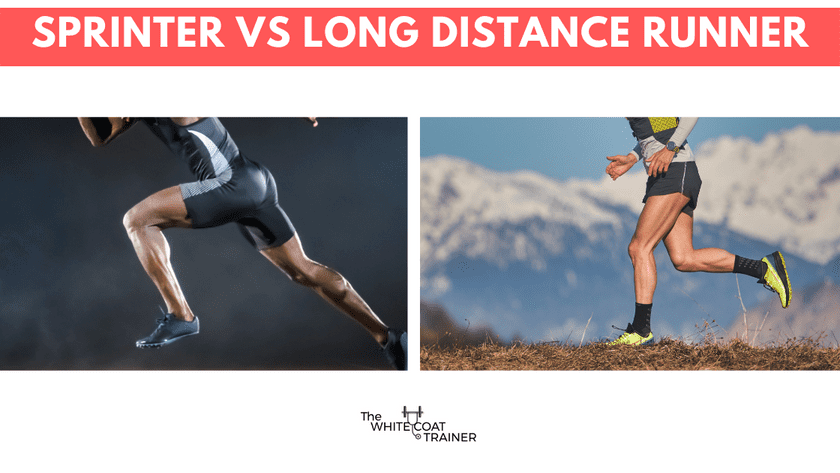Are you wondering if running makes your legs bigger or builds muscle?
You are in the right place!
In short, running can build muscle and make your legs bigger depending on the intensity and duration of your run.
Keep reading to learn more.

Does Running Make Your Legs Bigger?
Yes, running can make your legs bigger. However, the muscle size you might experience will depend on the type of running you do.
Running with a higher intensity (think sprinters) can lead to bigger legs than running with a lower intensity (think of a long-distance runner).
The reason is that high-intensity running activates fast-twitch muscle fibers, muscles responsible for explosive movements. These types of muscles create more force than slow-twitch fibers and thus, have the potential to lead to an increase in muscle size.
On the other hand, low-intensity running (long-distance running) activates slow-twitch muscles, which promote muscular endurance. These types of muscles are more efficient at using oxygen to create energy.
As a result, long-distance running won’t lead to as much muscle growth as high-intensity running.
Does Running Build Leg Muscle?
Yes, running can build muscle in your legs, specifically, the quads, hamstrings, glutes, and calves.
The key is to mix up your running routines with different intensities and durations to see the best results.
A 2015 analysis of several studies found that participants who performed aerobic exercise for an average of 12 weeks noted increased muscle mass in their legs (PubMed).
The results were consistent in both younger and older participants.
The authors conclude that aerobic work with progressively challenging intensity, duration, and frequency builds muscle by:
- increasing blood flow and nutrient delivery to the leg muscles
- decreasing myostatin (the protein that inhibits muscle growth)
- increasing insulin response and mitochondrial proliferation
If you are a beginner, you can expect the most gains in the size of your legs compared to a trained athlete.
How Much Muscle Do You Gain From Running?
This 2015 analysis of 14 studies found that by progressively adding intensity and duration to a running routine, runners can expect a 1-12% increase in their thigh muscle cross-sectional area (CSA).
With that said, if you already exercise regularly, you may not see as much muscle growth as a novice.
What Muscles Get Toned From Running?
All the lower body muscles will get some toning from running. However, the muscles that will see the most effect are the quadriceps, hamstrings, gluteus maximus, and calves.
Why Do Some Runners Have Skinny Legs?
The type of training that a runner does can influence leg size. Long-distance runners tend to have smaller muscles than sprinters because this form of endurance training is not conducive to muscle growth.
Similarly, diet can also impact leg size. If you are not eating enough calories, you will not have the energy or resources to build muscular legs.
Lastly, the most common reason for skinny legs is genetics. Some people naturally store less fat in their lower bodies, resulting in slimmer legs. Learn more about your specific body type here.

How Will Running Change My Body?
Running is a great way to get in shape and improve overall health. For starters, running can help strengthen your bones and reduce your risk of osteoporosis.
In addition, running can improve your cardiovascular fitness by increasing your lung capacity and reducing your blood pressure.
Lastly, running can promote mental health by releasing endorphins, improving mood, and alleviating stress.
How Quickly Does Running Change Your Body?
If you stick with a consistent running routine, you should start to see changes in your body within 4 to 8 weeks. You will likely see changes in your aerobic cardiovascular system first, followed by increased lean muscle in your legs.
Other Related Questions
Can You Lose Muscle By Running?
It is possible to lose muscle mass by running if you are not eating enough calories or running excessively.
Long distance running can burn a lot of energy and help decrease body fat. However, if you are not eating enough calories to fuel your running, you may experience muscle loss. The effects are compounded if you are not performing any strength training exercises to offset the muscle loss.
Why Do My Legs Look Bigger After Running?
Your legs may look bigger after running because of the increased blood flow to your muscles. When you run, your heart rate increases and pumps more blood through your body, especially to your legs.
This increased blood flow can temporarily cause your leg muscles to swell and look more prominent than usual.
Does Running Build Muscle In Arms?
While running does not directly target the muscles in your arms, it will indirectly help activate them. Running is a whole-body exercise that engages the core, arms, and lower body.
However, if you are looking to build arm muscle specifically, you will need to focus on resistance training exercises that target the biceps and triceps.
Does Running Build Muscle Your Abs?
Running can indirectly help to build muscle in your abs. When you run, your abdominal muscles work to stabilize your trunk, keeping your spine aligned and allowing you to maintain good posture. Since running is a full-body exercise, a strong core is necessary for stability and balance while running.
Does Running Build Calf Muscles?
Yes, running can build calf muscles. The calves are responsible for helping you push off the ground to propel you up and forward.
However, it is essential to remember that many factors contribute to muscle growth, including genetics, diet, and training frequency.
As a result, you may find that they need to do more than just run to build significant muscle mass in your calves.
How Do You Make Your Legs Bigger?
The best way to make your legs bigger is to use a combination of strength training and high-intensity cardio such as HIIT.
Focus on leg exercises targeting multiple muscle groups, such as squats, lunges, and deadlifts.
In addition, make sure you’re eating enough calories and protein to support muscle gain. Aim for at least 0.75 grams of protein per pound of body weight.
Can You Use Running To Make Your Legs Skinnier?
Yes, running can help to make your legs skinnier, but not directly. Running burns calories, which can lead to overall weight loss throughout your entire body. This calorie deficit may reduce leg size, especially if you intentionally eat fewer calories than you burn.
Unfortunately, running doesn’t target fat in specific areas of the body.
Final Words- Is Running Good For Gaining Muscle?
Running is a great way to improve your overall health and fitness. Running in different ways can build varying amounts of leg strength and muscle.
You are more likely to build leg muscle if you focus on gradually increasing your running intensity over time while avoiding longer distances.
However, if you want to gain a lot of muscle mass, you may want to focus on strength-training exercises that target the muscles you want to develop. In addition, make sure you are increasing your protein and calorie intake to support muscle growth.
Now I want to hear from you.
Do you prefer slim thighs or bigger thighs?
What kind of running workouts do you enjoy? A sprint or a marathon?
Comment below and let me know!

Alex Robles, MD, CPT / Brittany Robles, MD, MPH, CPT
Alex & Brittany Robles are physicians, NASM Certified Personal Trainers, and founders of The White Coat Trainer: a resource dedicated to improving the health and fitness of busy professionals using time-efficient strategies. Their advice has been featured in My Fitness Pal, Prevention, Livestrong, Reader’s Digest, Bustle, The Active Times, and more. Learn more about them here.
